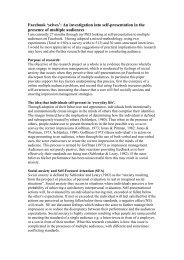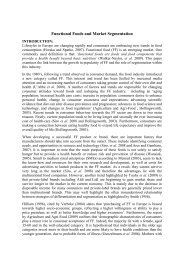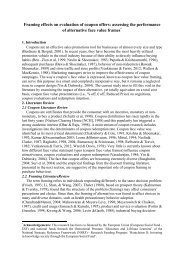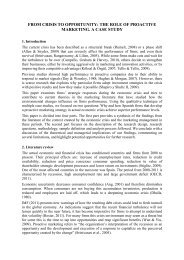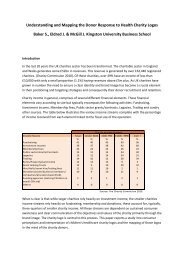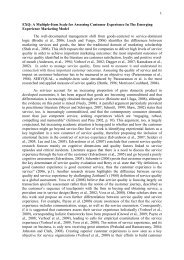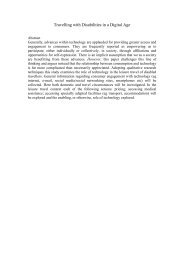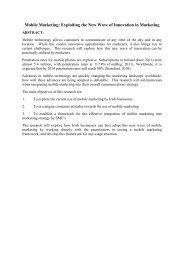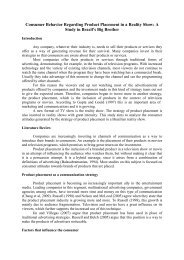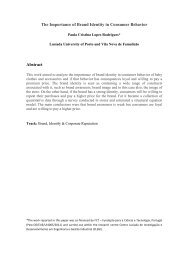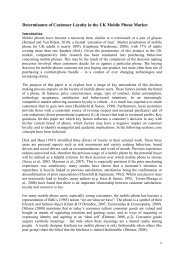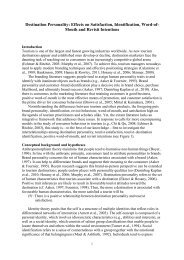The influence of positive and negative eWOM on purchase intention
The influence of positive and negative eWOM on purchase intention
The influence of positive and negative eWOM on purchase intention
Create successful ePaper yourself
Turn your PDF publications into a flip-book with our unique Google optimized e-Paper software.
intenti<strong>on</strong> was measured using five semantic differential items with seven resp<strong>on</strong>se categories<br />
(Brunner <str<strong>on</strong>g>and</str<strong>on</strong>g> Hensel, 1996).<br />
Analysis<br />
Refining the measurement model statistics resulted in deleting <strong>on</strong>e item from the integrity<br />
measure. <str<strong>on</strong>g>The</str<strong>on</strong>g> overall model fit statistics for the measurement model including all the<br />
c<strong>on</strong>structs was acceptable:<br />
Figure 2: Positive <str<strong>on</strong>g>and</str<strong>on</strong>g> Negative <str<strong>on</strong>g>eWOM</str<strong>on</strong>g> models<br />
CMIN (724) = 1325.472, p<br />
=.000, CMIN/DF = 1.831,<br />
TLI = .917, CFI = .926,<br />
RMSEA = .042. Metric<br />
invariance was also<br />
established across the<br />
<str<strong>on</strong>g>positive</str<strong>on</strong>g>/ <str<strong>on</strong>g>negative</str<strong>on</strong>g> scenarios.<br />
AVEs were generally<br />
acceptable (i.e., greater than<br />
.5), though some <str<strong>on</strong>g>of</str<strong>on</strong>g> the subdimensi<strong>on</strong>s<br />
<str<strong>on</strong>g>of</str<strong>on</strong>g> trustworthiness<br />
were marginal: benevolence =<br />
.49 (<str<strong>on</strong>g>negative</str<strong>on</strong>g> model), .48<br />
(<str<strong>on</strong>g>positive</str<strong>on</strong>g> model); integrity =<br />
.42 (<str<strong>on</strong>g>negative</str<strong>on</strong>g> model). All the<br />
CRs were above .7 except those associated with the lower than desired AVEs. <str<strong>on</strong>g>The</str<strong>on</strong>g><br />
discriminant validity <str<strong>on</strong>g>of</str<strong>on</strong>g> the<br />
trustworthiness sub-dimensi<strong>on</strong>s<br />
was c<strong>on</strong>firmed by the three factor<br />
model being a significantly better<br />
fit <str<strong>on</strong>g>of</str<strong>on</strong>g> the data than a single factor<br />
model (Hair et al., 2010).<br />
<str<strong>on</strong>g>The</str<strong>on</strong>g> structural models were<br />
fitted simultaneously. <str<strong>on</strong>g>The</str<strong>on</strong>g> model<br />
fit statistics were acceptable:<br />
CMIN (749) = 1353.142, p =.000,<br />
CMIN/DF = 1.807, TLI = .919,<br />
CFI = .926, RMSEA = .041. When<br />
the relati<strong>on</strong>ships between<br />
c<strong>on</strong>structs were c<strong>on</strong>strained to be<br />
equal across <str<strong>on</strong>g>negative</str<strong>on</strong>g> <str<strong>on</strong>g>and</str<strong>on</strong>g> <str<strong>on</strong>g>positive</str<strong>on</strong>g><br />
<str<strong>on</strong>g>eWOM</str<strong>on</strong>g> models there was a<br />
significant differences between the<br />
two models (∆χ² (13) = 32.037,<br />
Table 1: Structural Paths Estimates<br />
Paths Path estimates<br />
From To Both Positive Negative<br />
Expertise Ability .333<br />
Expertise Integrity .286<br />
Similarity Ability .228<br />
Similarity Integrity .219<br />
Benevolence Ability .580<br />
Integrity Benevolence .866<br />
Benevolence Purchase .367<br />
Expertise Purchase .242<br />
Similarity Purchase .791 .382<br />
In all cases p < .001<br />
Table 2: Direct <str<strong>on</strong>g>and</str<strong>on</strong>g> indirect effects<br />
Model Direct Indirect Total<br />
Positive <str<strong>on</strong>g>eWOM</str<strong>on</strong>g> .242 --- ..242<br />
Expertise Negative <str<strong>on</strong>g>eWOM</str<strong>on</strong>g> .242 .090 .332<br />
Positive <str<strong>on</strong>g>eWOM</str<strong>on</strong>g> .791 --- .791<br />
Similarity Negative <str<strong>on</strong>g>eWOM</str<strong>on</strong>g> .382 .070 .452<br />
p=.002), indicating differences between the <str<strong>on</strong>g>positive</str<strong>on</strong>g> <str<strong>on</strong>g>and</str<strong>on</strong>g> <str<strong>on</strong>g>negative</str<strong>on</strong>g> message scenarios. Each<br />
path was then individually c<strong>on</strong>strained to identify where the differences between the <str<strong>on</strong>g>positive</str<strong>on</strong>g><br />
<str<strong>on</strong>g>and</str<strong>on</strong>g> <str<strong>on</strong>g>negative</str<strong>on</strong>g> models occurred. Three paths differed: from Similarity to Ability, from<br />
Similarity to Purchase Intenti<strong>on</strong>, <str<strong>on</strong>g>and</str<strong>on</strong>g> from Benevolence to Purchase Intenti<strong>on</strong>. <str<strong>on</strong>g>The</str<strong>on</strong>g> resulting<br />
models are shown in Figure 2, Table 1 shows the regressi<strong>on</strong> weights <str<strong>on</strong>g>and</str<strong>on</strong>g> the effects <str<strong>on</strong>g>of</str<strong>on</strong>g> source<br />
characteristics <strong>on</strong> <strong>purchase</strong> intenti<strong>on</strong>s are in Table 2.



